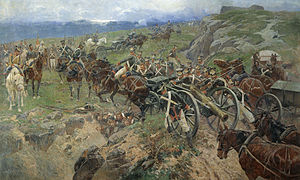Russo-Persian War (1826-1828)
| date | 1826 to 1828 |
|---|---|
| place | Transcaucasia , Northern Iran |
| output | Victory of the Russian Empire |
| Peace treaty | Turkmanchai Peace |
The Russo-Persian War from 1826 to 1828 was the last in a series of wars between the Russian Empire and Persia , the Russo-Persian Wars .
Cause and occasion
After the Peace of Gulistan , which ended the Russo-Persian War from 1804 to 1813, the Persian Shah Fath Ali came under pressure from the British to retake the territories. The British were trying to hinder Russia's expansion into Central Asia at the time.
After Tsar Nicholas I ascended the throne in 1825, Alexander Menshikov was sent to Persia to offer Shah Fath Ali an alliance with Russia against Turkey ; but the project failed partly because of Menshikov's harshness and partly because of the arrogance of the Shah. In the spring of 1826, Menshikov was placed under house arrest. On July 16, a 35,000-strong Persian army, led by Abbas Mirza , crossed the Russian border into the Talysh and Karabakh Khanates without declaring war .
course
Shortly after the invasion of the Persian army, the khanates of Baku , Quba and Talysh switched to the side of the Persians and left their cities to them without a fight. The Russian Governor General of the Caucasus, Alexei Yermolov , had the populous city of Gəncə evacuated because he had nothing to do with the enemy army. He stayed in Shusha , a small town in Karabakh, until September 5th, when reinforcements from General Madatov's troops arrived.
Madatov led the Russians to the banks of the Shamkhor and took Gəncə again on September 5. Thereupon Abbas Mirza lifted the siege of Shusha again and marched on Gəncə. Another Russian army under Ivan Paskewitsch soon reached Gəncə and together with Madatov's troops formed an 8,000-strong army under Paskewitsch's command. They were able to repel the Persians near the city and drove them behind the macaws .
In May 1827 marched Paskevich of Yerevan and took on the way to Echmiadzin one. Later he moved further south to the Abbasabad fortress on the Aras near Naxçıvan . The theater of war was now Armenia . In between, however, in August 1827 the Persian troops inflicted heavy losses on the Russian units under General Afanassi Krassowski near Oschakan . The capital of the Khanate Yerevan was taken by Paskevich on October 1st after a six-day siege. 14 days later, General Eristov advanced to Tabriz and forced the Shah to surrender.
In January 1828, Russian troops advanced as far as Lake Urmia , which is why Abbas Mirza quickly signed the peace treaty.
Result
On February 22, 1828, the Turkmanchai Peace Treaty was signed. Persia lost its influence on the khanates of Yerevan and Naxçıvan, which now belonged to Russia. In addition, the Shah had to pay 20,000,000 silver rubles and allow the migration of Armenians to Russia. In addition, the Russians were assured of maritime rule over the Caspian Sea and free trade.
Great Britain lost influence in Persia and Russia was able to secure its rule in the Caucasus. The outbreak of the war had first nourished Persian hopes and hindered final demands for peace from the Russian side, such as Alexander Griboyedov .
literature
- Paweł Borawski: Wojna rosyjsko-perska 1826-1828 (= Bitwy / Taktyka series , No. 38). Infort Editions, Zabrze and Tarnowskie Góry 2011, ISBN 978-83-89943-74-3 .
- N. Dubrovin: История войны и владычества русских на Кавказе , volumes 4–6. SPb, 1886-88.
- Gene. VA Potto: Кавказская война ... , volumes 1–5. SPb, 1885–86, reissued in 2006. ISBN 5-9524-2107-5 .
